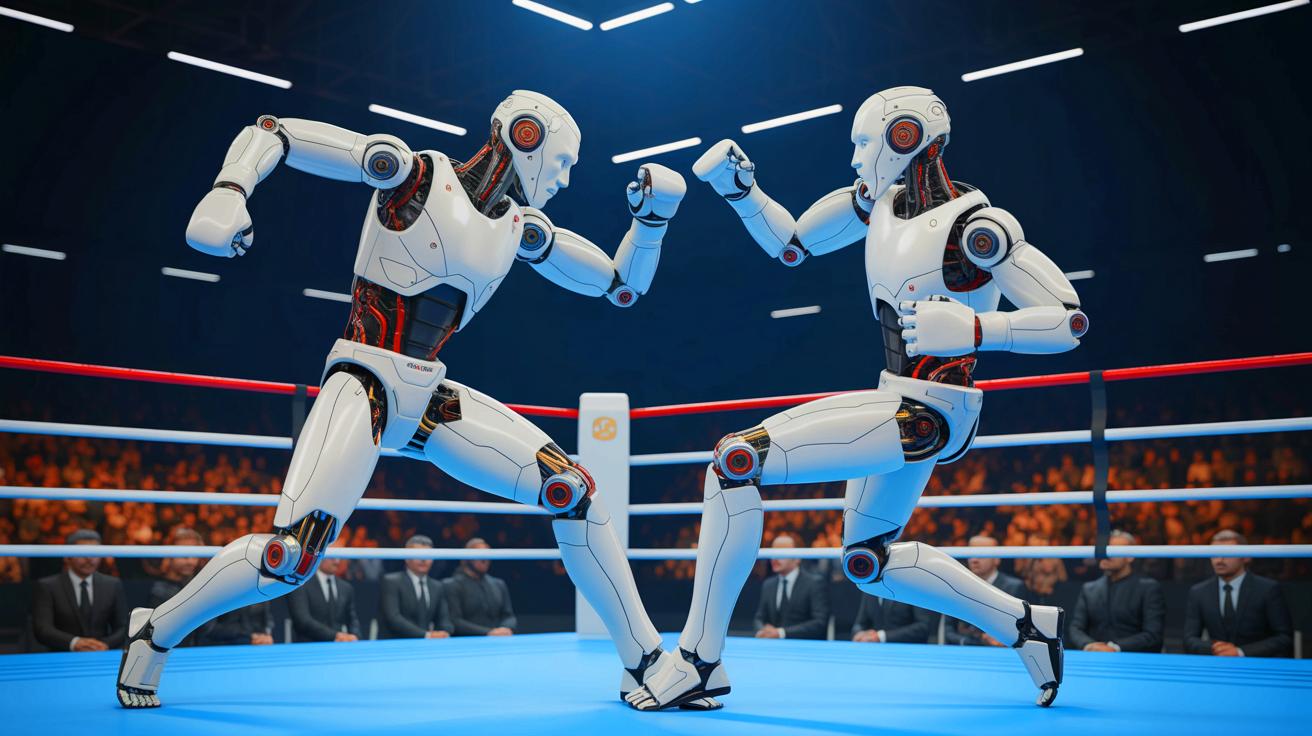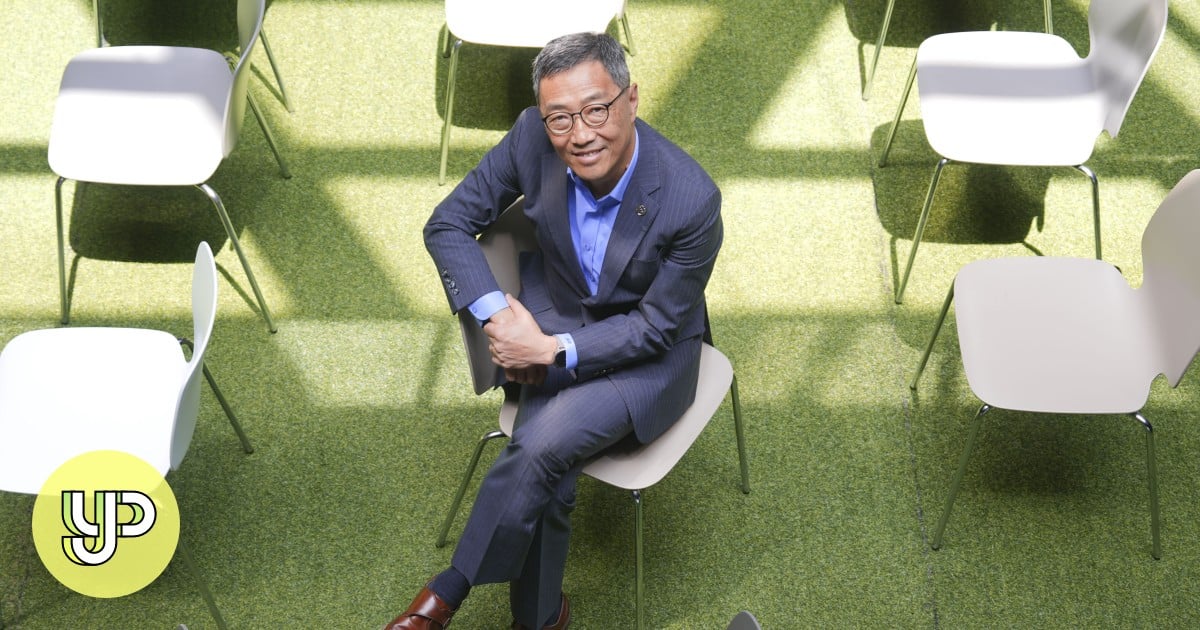Technology
“Robots in the Ring”: These Two Humanoid Fighters Are Kickboxing With Shocking Agility in a Spectacle That Blurs Man and Machine
IN A NUTSHELL 🤖 Humanoid robots participated in a historic kickboxing match in Hangzhou, China, showcasing the integration of AI in sports. ⚙️ These robots are controlled by human operators, highlighting the current blend of human skill and robotic technology. 🚀 The event underscores technological advances in AI, promising to revolutionize traditional sports and create […]

| IN A NUTSHELL |
|
The world of competitive sports is evolving rapidly, and nothing illustrates this better than the recent kickboxing match in Hangzhou, China, featuring two humanoid robots. These mechanical athletes, controlled remotely by skilled operators, engaged in a thrilling display of agility and precision. As they traded blows in the ring, it became clear that the future of combat sports may involve more than just human competitors. This event signifies a remarkable intersection of technology and athletics, demonstrating the potential for artificial intelligence (AI) to transform traditional sports.
The Rise of Humanoid Robots in Sports
Humanoid robots are not entirely new to the athletic scene, but their recent foray into combat sports marks a significant milestone. The event in Hangzhou showcased two slender, bipedal robots engaging in a dynamic match of kickboxing. Despite their thin frames, these robots delivered powerful punches, kicks, and knee strikes, captivating the audience with their performance. What makes this event particularly noteworthy is that it is the first of its kind, where humanoid robots are the main attraction in a combat sport setting. The audience watched in awe as the robots stumbled and fell but swiftly rose to continue the bout, demonstrating resilience and agility akin to human athletes.
While the robots themselves are impressive, it’s important to note that they are still reliant on human operators. These robots do not yet have the capability to act autonomously in the ring, as each move is orchestrated by a team of remote operators. This blend of human skill and robotic prowess represents the current state of AI integration in sports, highlighting both the advancements and limitations of technology in this field.
“It’s Not a Robot Anymore”: Boston Dynamics Unleashes Atlas With Superhuman 3D Vision—and It’s More Aware Than Most Humans
Technological Advances Driving Sports Innovation
The integration of AI and robotics into sports is fueled by rapid technological advancements. These humanoid robots are equipped with sophisticated sensors and actuators, enabling them to perform complex movements required in combat sports. The development of such robots involves interdisciplinary collaboration, combining expertise from robotics, AI, and sports science. This collaboration is essential for enhancing the robots’ performance, allowing them to mimic human movements more accurately.
Moreover, this event underscores the potential of AI to revolutionize traditional sports. As technology continues to evolve, we may see further incorporation of AI not only in combat sports but across various athletic disciplines. The implications are vast, ranging from improved training methods for human athletes to the creation of entirely new sports that challenge both human and robotic participants. The fusion of AI and sports promises to push the boundaries of what is possible, offering a glimpse into a future where technology and athletics are inextricably linked.
“Like a Snake Made of Origami”: This New Soft Robot Slithers Through Tight Spaces Using a Freaky Kirigami Skin
Implications for the Future of Competitive Sports
The introduction of humanoid robots into the realm of combat sports raises intriguing questions about the future of competitions. Will robots eventually compete independently, without human intervention? How will this shift impact the perception and popularity of traditional sports? As these technologies develop, they may pave the way for entirely new genres of sports that blend human and robotic elements. The excitement surrounding these events could attract new audiences, broadening the appeal of sports to tech enthusiasts and younger generations.
Furthermore, the integration of AI in sports could lead to enhanced safety protocols, as robots can be designed to minimize injury risks during competitions. This aspect is particularly relevant in contact sports, where athlete safety is a paramount concern. As AI continues to advance, it will be crucial to address ethical considerations, such as ensuring fair competition and maintaining the integrity of sportsmanship. The balance between human and machine in sports will likely be a topic of ongoing debate as the landscape of competitive athletics evolves.
“Robot Walks Out Alone”: Scottish Scientists Create 3D-Printed Creature That Moves on Its Own—No Wires, No Code, No Human Control
China’s Role in AI and Robotics Development
The event in Hangzhou highlights China’s growing influence in the field of AI and robotics. The country has invested heavily in these technologies, aiming to become a global leader in innovation. The development of humanoid robots for sports is just one facet of China’s broader strategy to integrate AI into various sectors, including military applications. Recently, China announced the construction of a giant quadruped military robot, signaling its commitment to advancing robotic capabilities.
This focus on AI and robotics positions China at the forefront of technological innovation, with implications extending beyond sports. As China continues to push the boundaries of what is possible with AI, it sets the stage for international competition in technology development. The outcomes of these advancements will shape not only the future of sports but also the broader landscape of AI applications worldwide.
The introduction of humanoid robots into combat sports is a testament to the rapid progress of AI and robotics. As technology continues to evolve, it will be fascinating to see how these developments influence the future of sports and beyond. Will we see a day where robots and humans compete side by side on equal footing? How will these innovations reshape our understanding of competition and athleticism in the years to come?
Our author used artificial intelligence to enhance this article.
Did you like it? 4.5/5 (28)
Technology
‘Technology is pervasive’: HKSTP CEO on young people in STEM and innovative AI – Young Post
Hong Kong Science and Technology Parks Corporation (HKSTP) will soon close a chapter as Albert Wong Hak-keung, its chief executive officer for nearly a decade, is set to retire at the end of July. “I’ve done what I know how to do. And I think that when everything is good, you should change … find […]

Hong Kong Science and Technology Parks Corporation (HKSTP) will soon close a chapter as Albert Wong Hak-keung, its chief executive officer for nearly a decade, is set to retire at the end of July.
“I’ve done what I know how to do. And I think that when everything is good, you should change … find new ways [to move forward],” Wong said.
Wong has been the head of the vibrant innovation and technology hub since 2016. He has spent his time in the role mentoring young, bright minds and creating opportunities for Hong Kong’s future generation of technicians, engineers, scientists and mathematicians.
He spoke to Young Post about all things STEM, education and learning.
STEM for Hong Kong students
Wong recognised the speed at which new discoveries, tools and inventions emerged in the 21st century. But for students and schools, he said, there was no need to stress about keeping up with these changes. Instead, they should focus on the basics.
“Physics, chemistry, biology, mathematics … personally, I still believe these are the most important basics,” he said.
Once you have mastered these foundational subjects, you could begin to specialise in a STEM field. Wong advised students to choose an area of study that aligned with their interests.
He added that even secondary students were perhaps too young to “determine what [their] career would be”. For example, while robotics and artificial intelligence are on the rise now, “the future has not happened yet”.
A driverless car by Apollo Go, Baidu’s robotaxi service, drives on a road in Wuhan, Hubei province, China. Photo: Reuters
Wong emphasised that while reading journals and studies was not necessary for every individual, it was essential to “keep your eyes open” and stay updated on developments in STEM. He encouraged students who were not as inclined to study STEM subjects to still learn what they could in school.
“Technology is pervasive,” he said. Lawyers would need to be aware of AI, and those in marketing may use the technology, he added.
“You don’t need to be a technologist, you don’t need to know how to code, you don’t need to know how to do biomedical research, but you have to know what is going on, because the future will be all about technologies.”
A Chinese start-up based in Shenzhen announced it had developed a new humanoid robot that can change its own batteries – allowing it, in theory, to work nonstop for 24 hours a day. Photo: Weibo
Time as a SOTY judge
Wong has been a judge at the annual Student of the Year (SOTY) Awards eight times.
The SOTY Awards are a competition organised by the South China Morning Post and solely sponsored by the Hong Kong Jockey Club.
Wong said he kept in touch with all the winners. As a judge, he said he looked at two things among the candidates: “One is how do you help others instead of just being a good student yourself? Two is … the aspiration.”
Wong explained that many SOTY Award recipients had a very “focused target” for their career or life goals. He described one such winner as a young man with an “entrepreneurial mind”. The student was a good coder and eventually worked at Google.
Luo Junhong, the 2021 Student of the Year’s scientist and mathematician award winner, receives the prize from Albert Wong, CEO of the Hong Kong Science and Technology Parks Corporation. Photo: SCMP
Another winner graduated from the Massachusetts Institute of Technology (MIT) – consistently ranked as one of the top universities in the world – and now worked in the financial industry.
“I cannot imagine myself doing that at that age,” said Wong, who was born and educated in Hong Kong.
But while he said these bright, top students deserved such opportunities, Wong stressed another focus. What was most important, he said, was not just helping the topmost student but also the ones in the middle.
“That is how we build a base [in Hong Kong],” he said.
Looking ahead
When asked about the future of STEM development in Hong Kong and globally, Wong highlighted artificial intelligence as a significant influence across various industries. But exactly how AI would affect humans and the economy was still to be determined, he said.
“It will definitely happen, but will be a different form that we do not visualise today,” he said. “[We are] still at the beginning.”
Wong also believed that, over the next three to four years, AI would take on a different form. Developers may start putting AI agents – a system that autonomously performs tasks using available tools – in everything, he said. That would include finding the right doctor or searching for groceries.
“I think teachers and students should learn more about the trend,” he said.
Albert Wong thinks all students, regardless of their grades or inclination for STEM, should stay updated on new tech and innovations. Photo: May Tse
Wong said he hoped Hong Kong would jump on these innovations.
“I don’t think we have done [them] justice in Hong Kong,” he said. “There weren’t opportunities because we focus on finance and tourism … [because it’s] quick money.”
This, he said, was the reason he worked outside Hong Kong for much of his career – because the opportunities in the city were so limited. Wong said he hoped that in the future, there would be more emphasis on technology, innovation and science.
“We owe it to the future generation to create … opportunities, internships, development [prospects], not just for the brightest students, but everyone,” he said.
Technology
Op-Ed: Should You Depend On AI To Navigate Legal Issues?
Editorial Note: Opinions and thoughts are the author’s own and not those of AFROTECH™. It’s easy to assume that just because you can use AI for something that you should use AI for everything. People are already using it to create websites, images, and videos. These uses of AI do not carry a lot of […]

Editorial Note: Opinions and thoughts are the author’s own and not those of AFROTECH™.
It’s easy to assume that just because you can use AI for something that you should use AI for everything. People are already using it to create websites, images, and videos. These uses of AI do not carry a lot of penalties if something is wrong (depending on what you are building). However, an area in which people are increasingly using AI and should be cautious is the legal system — navigating legal issues, creating legal documents, or doing legal research.
Ever since the release of ChatGPT over 2 years ago, we have seen people rush to bring AI to the world of professional services. Founders and investors alike have increasingly seen opportunity in leveraging AI to help in-house attorneys become more effective, and the everyday citizen has been looking to use AI instead of paying the cost of employing an attorney.
Legal tech companies have made it their mission to reinvent legal professions and workflows from the ground up, using AI to automate the mundane tasks they do so they are able to focus on higher-value tasks. The economic potential of this has caused the investment in AI-focused legal tech companies to grow in recent years. Crunchbase reported that 79% of legal startup investments since 2024 — around $2.2 billion — have a focus on AI.
Given how often venture capital firms and owners of companies have to work with their legal counterparts, it makes sense that we see venture dollars going into a profession that people have familiarity with. And considering the amount of investment, there are a lot of players looking to create more AI-enabled attorneys, but there are some companies that have risen to the top.
Harvey was founded in 2022 by Winston Weinberg, who was a former antitrust and securities litigator, and Gabriel Pereyra, who previously worked in AI at Google, Deepmind, and Meta. While most of the venture capital attention goes towards automation, Harvey’s founders decided to focus on augmentation and being an assistant to lawyers and attorneys instead of a replacement for them. Harvey helps firms with everything from contract analysis to litigation assistance and regulatory compliance, and the company primarily focuses on the Fortune 500 or Big Law firms. As reported by TechCrunch, it recently raised $300 million in a Series E funding round and is valued at $5 billion. While Harvey has claimed headlines here in the U.S., there is a firm based in the United Kingdom that is grabbing headlines across the pond.
The Solicitors Regulation Authority, an independent body that aims to keep high professional and ethical standards in the United Kingdom’s legal profession, reported that it has authorized Garfield.Law ltd as the first purely AI-based firm to operate in England and Wales. Garfield’s focus is to enable small and medium-sized businesses and large enterprises to recover unpaid debts in small claims court in the English and Welsh system. This is a case where AI works well because in those systems, small claims have to go through specific, mundane steps, and those types of systems are always ripe for automation. What we are seeing is that augmenting workers and automating workflows has a place for AI as it grows in the legal profession. However, companies aren’t the only ones looking to see how they can leverage AI. People are trying to use it to navigate legal scenarios in their daily lives as well.
Fox 5 Atlanta reported that Georgia’s court of appeals has fined an Atlanta-based attorney for citing cases that did not exist in their motion for a client’s divorce case. It was also found that there were references made that did not exist. The attorney was fined $2,500, and the case has been sent back down to the lower court to be reconsidered. A real risk of using AI in legal matters is that it can have a tendency to make things up, which is what AI researchers call “hallucinations.” These hallucinations can put people in hot water if they are used to justify positions or make decisions that have legal implications attached to them. Situations like these make it so I would not recommend that people use AI, unless they are legally trained themselves to navigate legal situations. I understand the incentive to save money by not contacting an attorney and turning to AI, but that can cause more costly issues down the road if people are not careful.
I believe that AI will continue to be leveraged in legal offices and law firms around the world to give attorneys their time back in ways that will be beneficial to their clients and their case load. But I am wary of the average person believing that they can represent themselves because ChatGPT told them they could. Often, people believe that what is most cost effective is the most effective, and that is not always the case.
Technology
Skechers Enhances Retail Presence with Renovated New Delhi Store
New Delhi, July 26th, 2025: Skechers, the Comfort Technology Company®, unveiled its newly revamped New Delhi store at Pacific Mall Tagore Garden. The latest update among Skechers’ 52 retail stores across the city, the 2,472-square-foot destination showcases the brand’s lifestyle and performance footwear and apparel collections as well as dedicated specialty sports zones, ensuring patrons […]

New Delhi, July 26th, 2025: Skechers, the Comfort Technology Company®, unveiled its newly revamped New Delhi store at Pacific Mall Tagore Garden. The latest update among Skechers’ 52 retail stores across the city, the 2,472-square-foot destination showcases the brand’s lifestyle and performance footwear and apparel collections as well as dedicated specialty sports zones, ensuring patrons can find a diverse assortment of comfortable lifestyle and technical performance product under one roof.
The brand celebrated the store re-opening by hosting its ninth Skechers Community Goal Challenge. The high-octane event, which took place today, July 25th, was headlined by the versatile actress and fitness enthusiast, Bhumi Pednekar. She joined forces with the participants in a collective mission to complete a 1,000-kilometer run on treadmills at the new store. The challenge, a continuation of Skechers’ CSR-led store launch initiatives, successfully fostered community spirit and inspired attendees to push their fitness boundaries.
Upon reaching the 1,000-kilometer goal, Skechers donated 100 pairs of children’s footwear to The Kutumb Foundation, an NGO dedicated to empowering children and youth from disadvantaged backgrounds through education, sports and social development. This donation reflects Skechers’ ongoing commitment to nurturing the well-being of future generations and promoting grassroots sports development as a vital part of youth empowerment.
Talking about the store and event, Rahul Vira, CEO, Skechers South Asia Pvt. Ltd., said, “New Delhi is a pivotal market for us, and this launch represents our commitment to providing a world-class shopping experience to its dynamic and fitness-conscious population. This store is designed to be a one-stop destination for sports lovers, with dedicated areas for our specialty sports category. The Community Goal Challenge embodies our core values of promoting fitness while giving back to the society. Partnering with The Kutumb Foundation allows us to make a meaningful impact and support the incredible work they do for children in the city.”
Actress Bhumi Pednekar, added, “It was truly wonderful to be part of an event that combines fitness with a powerful cause. The energy and determination of everyone who participated in the Skechers Community Goal Challenge was overwhelming. For me, wellness is about uplifting community and supporting one another, and it was a privilege to connect with the people of New Delhi today. Platforms like this allow us to come together to create positive change through shared passion and efforts.”
From lifestyle products to performance shoes for sport enthusiasts, Skechers’ offering is enhanced with the Company’s signature comfort innovations—including its Skechers Hands Free Slip-ins® Technology, Skechers Arch Fit® Technology, Skechers Max Cushioning® Technology, Skechers Hyper Burst® Technology, Skechers Air-Cooled Memory Foam®, Skechers Relaxed Fit® Technology and Skechers Stretch Fit® Technology.
Skechers maintains an extensive and robust network of 435 retail stores throughout India, offering wide accessibility to its customers. Consumers can also shop at skechers.in and leading retailers across the country.
Technology
Trump’s Push to ‘Save College Sports’ May Fall Short Without Congress, Experts Say
Sulaiman Abdur-Rahman “We are very proud of this landmark settlement which will transform the lives of college athletes and bring them tens of billions of dollars in damages and future benefits,” Jeffrey Kessler, co-executive chairman of Winston & Strawn, said of the antitrust class-action settlement providing $2.576 billion in compensation to college athletes for their […]

Sulaiman Abdur-Rahman
“We are very proud of this landmark settlement which will transform the lives of college athletes and bring them tens of billions of dollars in damages and future benefits,” Jeffrey Kessler, co-executive chairman of Winston & Strawn, said of the antitrust class-action settlement providing $2.576 billion in compensation to college athletes for their name, image and likeness and nearly $500 million in fee awards to class counsel.
Technology
Fitness, Tech, and Home Essentials at Unbeatable Prices
The 9to5Toys Steals Weekly roundup features discounted everyday essentials, including a 7-pack of quick dry workout shirts for $36, a wireless CarPlay adapter for $30, and a 4-pack of neodymium AirTag cases for $7.50 each. Other steals include a clamp-on desk lamp for $59.50, three polos for $6.50 each, and a Gerber Paraframe Mini pocket […]

The 9to5Toys Steals Weekly roundup features discounted everyday essentials, including a 7-pack of quick dry workout shirts for $36, a wireless CarPlay adapter for $30, and a 4-pack of neodymium AirTag cases for $7.50 each. Other steals include a clamp-on desk lamp for $59.50, three polos for $6.50 each, and a Gerber Paraframe Mini pocket knife for $12.50.
Technology
Microsoft CEO Satya Nadella Breaks Silence After 15,000 Layoffs, Says Company Must Evolve Or Fall Behind
Microsoft layoffs: Microsoft CEO Satya Nadella spoke about the recent round of layoffs affecting more than 15,000 workers in 2025 as one of the toughest leadership decisions. In spite of the sweeping cuts, Nadella underscored that the company is resounding, fueled by strategic shifts in artificial intelligence, cloud computing, and enterprise technology. In an emotional letter […]

Microsoft layoffs: Microsoft CEO Satya Nadella spoke about the recent round of layoffs affecting more than 15,000 workers in 2025 as one of the toughest leadership decisions. In spite of the sweeping cuts, Nadella underscored that the company is resounding, fueled by strategic shifts in artificial intelligence, cloud computing, and enterprise technology. In an emotional letter to staff, Nadella wrote, “Before anything else, I want to address what’s been on my mind, and what I know many of you are wondering about: the recent job eliminations. These are some of the toughest decisions we have to make.”
Microsoft has undergone at least four major rounds of workforce reduction this year, cutting approximately 15,000 roles across several divisions. In early July alone, 9,000 jobs were eliminated, affecting Xbox sales and regional offices, including about 850 jobs in Washington state. These cuts notwithstanding, the company’s worldwide headcount is effectively stable, as Microsoft continues to hire in key fields, specifically around AI and cloud infrastructure.
‘The Enigma of Success’: Microsoft’s Balancing Act
Describing the paradox of cutting jobs while achieving record market performance, Nadella referred to the situation as an “enigma of success.” He emphasized that technology companies must constantly evolve to stay relevant and competitive in today’s dynamic environment. “We are no longer just a software factory. We’re becoming an intelligence engine, empowering every individual and organization to build whatever they need to achieve using AI,” he said.
Following its shift to AI-driven services, Microsoft has now made AI use a part of formal employee performance reviews. Julia Liuson, President of Microsoft’s Developer Division, notified employees that employing AI tools such as Microsoft Copilot is “no longer optional — it’s core to every role and every level.” Internal talks are said to be ongoing to add AI usage metrics to employee reviews next year as the company encourages wider use of its AI platforms. Microsoft’s most recent round of layoffs hit particularly at traditional sales jobs, which the company intends to discontinue in favor of more technical “solutions engineers.” The new positions are meant to showcase AI-powered tools directly to customers, consistent with Microsoft’s goal of “a Copilot on every device and across every role,” according to Sales Chief Judson Althoff.
ALSO READ: Microsoft Closes Pakistan Office, Big Embarrassment As Global Firms Lose Confidence In Local Market: Reports
JD Vance Criticizes Microsoft’s Hiring Practices
In contrast, US Vice President JD Vance has publicly chastised Microsoft for the mass layoffs of American employees while persistently applying for H1-B work visas. “I don’t want to see companies lay off 9,000 American workers and then tell me that they can’t find talent here. That’s a bulls**t story,” Vance declared, urging a re-examination of tech industry hiring practices. To get its workers ready for this changing world, Microsoft is encouraging its remaining staff to “invest in your own AI skilling.” The company is providing internal training and resources to assist employees in moving into more AI-driven positions.
ALSO READ: 61,000 Tech Jobs Lost In 2025: Big Tech Like Microsoft, Google And Amazon Lead Layoff Wave, Is AI To Blame?
Microsoft has spent about USD 80 billion on AI infrastructure in FY25 as it looks to become “the Frontier AI firm.” Microsoft is intent on infusing AI throughout its product stack, from Azure to Office to Windows. While the magnitude of the job cuts has caused anxiety, Microsoft’s management is adamant that the changes form part of an inevitable transformation to succeed in the AI-first world. As AI becomes the core of all jobs and performance indicators, Microsoft’s latest actions portend an even deeper restructuring of the contemporary workforce.
-

 College Sports3 weeks ago
College Sports3 weeks agoWhy a rising mid-major power with an NCAA Tournament team opted out of revenue-sharing — and advertised it
-

 Sports3 weeks ago
Sports3 weeks agoNew 'Bosch' spin
-

 Fashion2 weeks ago
Fashion2 weeks agoEA Sports College Football 26 review – They got us in the first half, not gonna lie
-

 Sports2 weeks ago
Sports2 weeks agoVolleyball Releases 2025 Schedule – Niagara University Athletics
-

 Health2 weeks ago
Health2 weeks agoCAREGD Trademark Hits the Streets for Mental Health Month
-

 Sports3 weeks ago
Sports3 weeks agoE.l.f Cosmetics Builds Sports Marketing Game Plan Toward Bigger Goals
-

 Youtube3 weeks ago
Youtube3 weeks agoWill LeBron James request a trade? 🤔 Windy says MULTIPLE TEAMS would make offers 👀 | NBA Today
-

 Youtube2 weeks ago
Youtube2 weeks agoWill Giannis DEPART Milwaukee⁉️ + How signing Turner & waiving Dame impacts the Bucks | NBA Today
-

 College Sports2 weeks ago
College Sports2 weeks agoBuford DB Tyriq Green Commits to Georgia
-

 Sports2 weeks ago
Sports2 weeks agoNew NCAA historical database provides wealth of information on championships
























